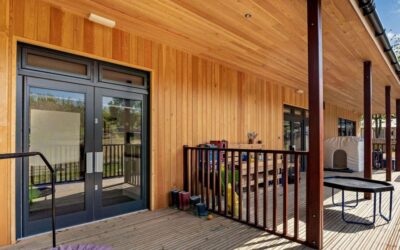TG Escapes Blog
How Educational Environments Impact Mental Health
The conversation around mental health in schools has never been more vital, with increasing recognition of how the physical spaces in which we learn and teach can significantly impact our psychological health and academic performance.
Our team understands the tangible ways that forward-thinking modular construction can contribute to more supportive, engaging, and healthy learning environments. We’ll provide you with suggestions and examples of ways educators could consider improving mental health in all areas of education – not just classroom design.
How your environment affects mental health
The significance of the learning environment on the mental health of both students and educators cannot be overstated. Research and expert opinions consistently demonstrate that the physical surroundings in educational settings play a crucial role in shaping mental well-being. A 2020 study conducted for the International Journal of Environmental Research and Public Health indicated that daylighting parameters have an impact on children’s performance in schools, while a 2021 study discovered associations between natural window views and lower levels of perceived stress, higher levels of attention paid, and improvements in perceived well-being.

The power of biophilic design
An idea often central to optimising educational environments for mental well-being is biophilic design. This integrates natural elements into the built environment. Biophilic design choices work to tap into humanity’s innate connection to nature and foster environments that are inherently restorative and uplifting.
A growing body of evidence (including published studies in 2014 and 2021) has shown that biophilic design offers a myriad of benefits for mental health, including stress reduction, improved mood, and enhanced cognitive function among students and staff alike. The presence of plants, natural materials, and views of nature within educational spaces therefore not only brings beauty into the learning environment but can also serve as a powerful tool in promoting psychological well-being.
By incorporating biophilic design principles, educational institutions can create spaces that not only support academic achievement but also nurture the mental health of their communities, making it a critical consideration in the design and layout of schools and campuses.
Learn more about the power of biophilic design within education.
How modular buildings can enhance mental health
We are fully committed to providing environments that support and enhance mental health through the thoughtful application of sustainable and biophilic design principles. This design philosophy acknowledges the intrinsic human need to connect with nature and seeks to embed this connection into the very fabric of educational spaces.
By prioritising natural light, open spaces, and direct links to the natural world, TG Escapes’ modular buildings are crafted to create environments that not only inspire learning but also promote psychological well-being and resilience among students and educators.
Biophilia in action
The staff at Nursery @ St Fagan’s Primary, Cardiff, claimed to have seen improvements in young children’s behaviour once settled into one of our biophilic modular buildings.
Enhancing other school spaces
Classrooms are not the only space which can be enhanced to improve mental health and wellbeing. The design and allocation of physical spaces within schools also play a pivotal role. Among these, the creation of designated relaxation zones or quiet areas is a key strategy in promoting well-being among students and staff. These dedicated spaces help individuals to find a moment of peace, unwind, and recharge, acknowledging the importance of mental health and the need for balance in the education system.
Relaxation zones are typically designed with comfort and tranquillity in mind, often featuring soft furnishings, calming colours, and elements of nature. They may include indoor plants that individuals can interact with, which may reduce psychological and physiological stress, water features, which are suggested to promote psychological health and health-related behaviours, or access to natural light. The incorporation of biophilic design principles enhances the therapeutic quality of these spaces, leveraging nature’s inherent ability to reduce stress and improve mood.
The impact of relaxation zones
Relaxation zones provide a physical space where the mind can take a break from academic pressures, social dynamics, and other stressors inherent to school life. For students, these areas can be a refuge for quiet study, mindfulness practices, or simply a place to breathe and enjoy a moment of solitude. For educators and staff, relaxation zones offer a much-needed pause in their day, supporting their well-being and enabling them to sustain their commitment to their students’ learning and development.
By prioritising the creation of relaxation zones within school layouts, educational institutions send a powerful message about the value they place on mental health. These spaces symbolise a commitment to creating a supportive and inclusive learning environment, where the well-being of every member of the school community is nurtured. Through thoughtful design and intentional use of space, schools can become places where mental health is actively promoted, contributing to a more positive, productive, and healthy educational experience.
Physical activity and mental health in schools
The connection between physical activity and mental health is well-established, with numerous studies highlighting the positive impact that an active lifestyle can have on emotional and psychological well-being. Engaging in regular physical activity is known to reduce symptoms of depression and anxiety, enhance mood, and improve self-esteem and cognitive function. For students, the benefits extend into the classroom, where increased physical activity is associated with reductions in anxiety, increased resilience, improved well-being and positive mental health.
Recognising the importance of this connection, schools have a unique opportunity and responsibility to encourage students to lead more active lifestyles. This encouragement can take many forms outside of a traditional classroom, to integrate physical activity into the daily routine of students in engaging and enjoyable ways:
- Sports Programmes: Offering a diverse range of sports programs that cater to different interests and abilities ensures that every student has the opportunity to participate in physical activities they enjoy. This can include team sports, individual sports, and non-traditional sports activities, promoting inclusivity and a love for being active.
- Active Breaks: Implementing active breaks during the school day, where students are encouraged to stand, stretch, or engage in short bursts of physical activity, can help to break up periods of sedentary behaviour and rejuvenate their minds and bodies.
- Extracurricular Activities: Extracurricular activities that involve physical movements, such as dance clubs, hiking clubs, or martial arts, offer students additional avenues to engage in physical activity outside of traditional sports programs. These activities can also foster a sense of community and belonging among participants.
- Incorporating Movement into Lessons: Educators can look for creative ways to incorporate movement into their teaching methods. This might include lessons outdoors, learning activities that involve physical movement, or using standing desks in the classroom to promote a more active learning environment.
- Promoting Active Transportation: Encouraging students and their families to consider active forms of transportation, such as walking or biking to school, can contribute to their daily physical activity levels and foster an early appreciation for an active lifestyle.

Incorporating mental health into your curriculum
The integration of mental health education into the school curriculum is a critical step towards empowering students and staff with the knowledge and tools necessary to recognise, understand, and effectively manage mental health issues. This educational approach serves not only to destigmatise mental health challenges but also to foster a school environment where mental well-being is openly discussed, understood, and prioritised alongside physical health and academic achievement.
To effectively integrate mental health education into the curriculum, schools can adopt a multi-faceted approach that includes:
- Dedicated Lessons and Modules: Incorporate lessons on mental health into the health education curriculum, ensuring students receive comprehensive and age-appropriate information.
- Professional Development for Staff: Offer training and workshops for teachers and school staff on mental health awareness and intervention, enabling them to support students effectively.
- Resource Availability: Provide students and staff with access to mental health resources, including information on local mental health services, self-help materials, and online tools.
- Inclusive Activities: Design classroom activities and discussions that encourage students to share their experiences and perspectives on mental health, fostering an inclusive and supportive community.
- Cultural and Social Sensitivity: Emphasise the need for culturally and socially sensitive practices that respect the diverse backgrounds and experiences of the school community, promoting inclusivity and understanding.
- Anti-Bullying Policies: Address the importance of robust anti-bullying policies and practices to create safe and inclusive environments where all students feel valued and protected.
- Fostering Peer Networks: Highlight the benefits of establishing peer support networks or mentorship programmes where students can offer mutual support under guided supervision, fostering a sense of community and belonging.
- Implementing Mindfulness Programmes: Suggest the implementation of mindfulness and stress reduction techniques as part of the school routine, offering practical exercises that students and staff can use to manage stress and enhance focus.
- Personalised Support Plans: Suggest the development of personalised support plans for those requiring additional assistance.
Engaging parents and your wider community
Fostering a supportive environment for mental health in schools extends beyond the classroom and into the broader community. Engaging parents and the wider community in mental health initiatives is crucial for creating a unified approach to supporting student well-being. By building strong partnerships with these stakeholders, schools can enhance the effectiveness of their mental health programmes and ensure a consistent support network for students both in and outside of school.
Creating channels for sharing information and resources with parents on supporting their children’s mental health and well-being at home is another critical component of engaging the wider community. Schools can develop newsletters or organise workshops that provide parents with practical advice on recognising signs of mental distress, fostering open communication about mental health, and implementing strategies to support emotional well-being at home. Additionally, schools can serve as a bridge to local mental health services, guiding families to professional support when needed.
Building up mental health with TG Escapes
Our team is dedicated to understanding the specific needs of UK schools and transforming them into reality with innovative modular buildings. The bespoke nature of our design process ensures that the integration of biophilic elements is used to create an environment that best supports the mental health and academic success of your community.
Reach out to us today to learn more about our unique design approach and all-in-one service.
About the author
More posts from our blog
Education Estates 2025: Surrey County Council Share Their SEND Provision Strategy, Including the Contribution Made by TG Escapes
At the recent Education Estates 2025 conference, I was proud to join Euan Leslie, Programme Manager for our partners Surrey County Council as we presented their ambitious and highly successful strategy for expanding Special Educational Needs and Disabilities (SEND)...
Supporting Active School Life With Modular Sports Pavilions
Physical activity is a crucial part of everyday schooling across the UK. But in many settings, ageing facilities and limited space can prevent pupils from getting the full benefit of PE, sport, and outdoor recreation. Modern sports and leisure pavilions offer an...
Creating Calm, Purposeful Spaces for SEMH Learners
For students with Social, Emotional, and Mental Health (SEMH) needs, the right environment can make a world of difference. In an ideal setting, buildings are a key part of the therapeutic process, shaping behaviour, supporting emotional regulation, and helping...



